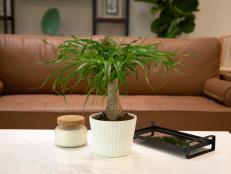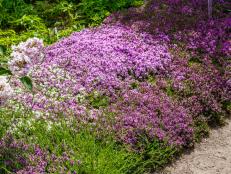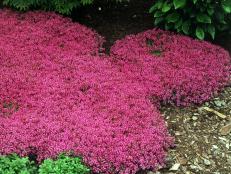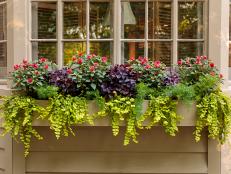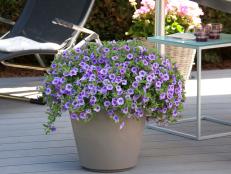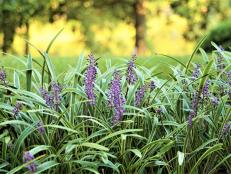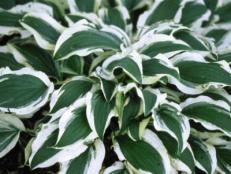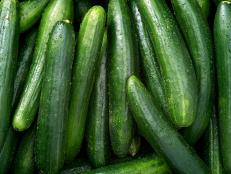How to Grow Creeping Jenny
Plant a creeping jenny groundcover or let its green stems tumble from containers. Lysimachia is fast-growing and versatile.
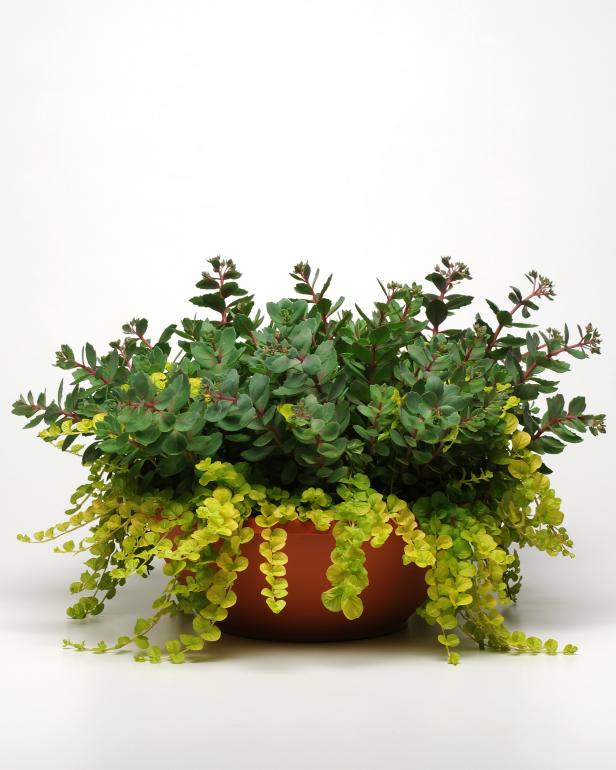
Ball Horticultural Company
Let creeping jenny trail from containers of mixed perennials. Also known as moneywort, the plants add interest to a pot of 'Vera Jameson' sedums.

We're not sure how creeping jenny got its common name. "Creeping" describes how this low-growing perennial spreads, but “Jenny” is harder to figure out. According to the book Gerard's Herbal first published in 1597, creeping jenny plants were once used to treat children with "Chin-cough." Today we call it whooping cough, and it's possible that "Chin" evolved into “Jenny.”
Creeping jenny perennials, or Lysimachia nummularia, get their botanical name from the Latin word, nummularia, which means “resembling a coin.” Their small, shiny leaves are coin-shaped, which explains why creeping jenny plants are also called moneywort. Twopenny grass and herb twopence are less common names.
What is Creeping Jenny?
Native to Europe and Western Asia, creeping jenny plants are in the Primulaceae family. They make great groundcovers because they form attractive, dense mats between stepping stones, in rock gardens and around ponds and other water features. They tolerate light foot traffic, and most types are hardy in USDA Zones 4 to 9.
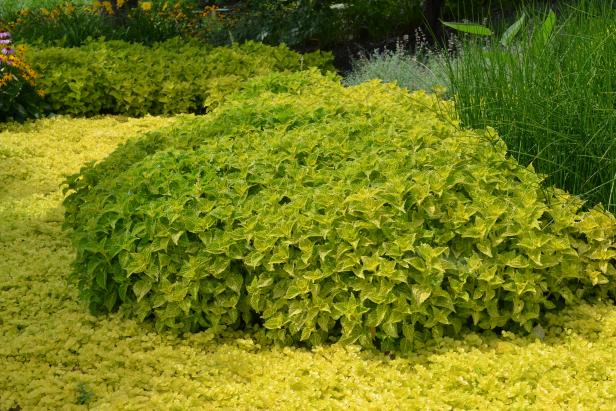
Ball Horticultural Company
Lysimachia 'Goldilocks' forms a dense carpet of lighter green when planted around coleus 'Electric Lime.'
Many gardeners use creeping jenny in pots, window boxes and other containers, where their stems can trail over the edges. In a creeping jenny hanging basket, they work as thrillers or spillers when combined with upright plants. They can also be allowed to spill down banks or slopes. In spring or mid-summer, small, yellow, creeping jenny flowers brighten up the evergreen foliage.
Because they spread easily and need little care, creeping jenny plants are considered invasive in some areas. Introduced to the US as ornamentals and ground covers, creeping jenny plants now grow wild in many areas, including floodplain forests, swamps, marshes, ditches and roadsides. Before planting creeping jennys, ask your local extension service if they are prohibited in your region.
How to Plant Creeping Jenny
If you're wondering how to plant creeping jenny, you can give it full sun to part shade. Plants often turn more yellow-gold in full sun, but too much sun in very hot weather can bleach the leaves.
Creeping jenny needs well-draining sand, loam or clay, and these vigorous plants are not picky about soil pH. Plant them in early spring in moist soil. In the garden, place them 2 feet apart and they'll spread in all directions to form a dense carpet about 2 to 4 inches tall and 12 to 18 inches across. Creeping jenny perennials can quickly spread and overrun other plants, so use containers or keep them away from other plants if overcrowding is a concern. Cut back the plants as needed; they'll regrow fast.
Water
Don't let the soil dry out. Keep creeping jennys moist, not soggy. Water around the base of the plants to avoid splashing the leaves.
Fertilize
Feed creeping jenny plants in the spring with a balanced fertilizer like 10-10-10. Use the amount indicated on your product label.
Weed
In the garden, creeping jenny is aggressive enough to crowd out most weeds, but remove them if needed so there's less competition for nutrients and water.
Scout For Health Issues
Insect pests seldom bother creeping jenny ground covers or container plants, although slugs can be a problem. Control them with slug baits or traps. Fungal disease can occur when conditions are wet. If needed, divide or cut back the plants for better air circulation and watch for these fungal diseases:
- Southern blight: Wilting or yellowing leaves, stem lesions and white, webby growths in the soil around creeping jenny plants are signs of this blight. You may also see tan or brown sclerotia (hardened masses of fungal spores) on the plants or in the soil. There's no treatment, so remove dead or dying plants.
- Botrytis blight: Also known as gray mold, this fungus attacks during rainy conditions when the temperature is around 60 degrees. Symptoms include silver-gray spores that scatter like dust. Treat with a liquid copper fungicide as the product label directs.
- Phyllosticta leaf spot: Suspect this disease if you see brownish spots with dark edges on creeping jenny leaves. In time, the centers of the spots dry up, leaving holes. This problem isn't usually serious enough to treat.
Since fungal diseases can overwinter in plant debris, keep the garden or the area around your containers clean. Also, don't handle creeping jenny plants when the foliage is wet.
How to Propagate Creeping Jenny Plants
Propagating creeping jenny is easy. If allowed to run over the soil, the stems usually take root and spread. You can also dig up a clump of creeping jenny plants with roots and simply divide them.
Another method for propagating creeping jenny: Make 2-inch stem tip cuttings just below a leaf or bud. Dip them in rooting hormone and put them in moist potting soil. Cover them with clear plastic and keep them in bright, indirect light until they root. Transplant them into pots and harden them off before moving them into a sunny or partially shaded spot.
Sometimes, creeping jenny seeds drop and resprout. If you want to sow the seeds yourself, start them outdoors in trays of moist seed starting mix in the fall. Sink the trays into the ground in a shady spot and cover them with clear plastic. Keep them moist until the seedlings germinate, usually in one to three months. Wait until they start to creep or trail before transplanting them.
Types of Creeping Jennys
Only two types of creeping jenny plants, 'Goldilocks' and 'Aurea,' are commonly grown. Lysimachia 'Goldilocks' is hardy in Zones 3 to 10 and resists deer. The plants mature at 2 to 4 inches high, spread 12 to 14 inches and have green and yellow foliage. Lysimachia 'Goldilocks' doesn't need deadheading.

Proven Winners
Let creeping jenny's small leaves and trailing stems contrast with plants with bigger leaves and different textures. Shown here: Proven Accents Lysimachia 'Goldilocks'
Lysimachia 'Aurea' is known as golden creeping jenny. It's hardy in Zones 3 to 9 and ranges in color from lime green to yellow gold to chartreuse. Grow golden creeping jenny as a ground cover, bog plant, in containers, on a bank or around a pond, stream or creek. A creeping jenny hanging basket of 'Aurea,' whether or not it's mixed with other plants, is also stunning.
'Golden Globes' loosestrife (Lysimachia confestiflora) is less common, but it's sometimes called creeping jenny and belongs to the same family. Use it in containers as a flowering annual or as a perennial groundcover in Zones 6 to 9. Golden yellow, cup-shaped blooms open in spring and summer among the green leaves.
Creeping Jenny Companion Plants
Gold or green creeping jennys are striking when combined with darker colors or taller plants. Try them with dark-leaved heucheras, ornamental sweet potatoes (Ipomoea batatas), purplish-red nandinas, red-leaved cordylines or Japanese barberry shrubs. Grow a creeping jenny groundcover with bulbs like tulips and daffodils, under roses, or around catmint, daylilies, hydrangeas and ferns.






